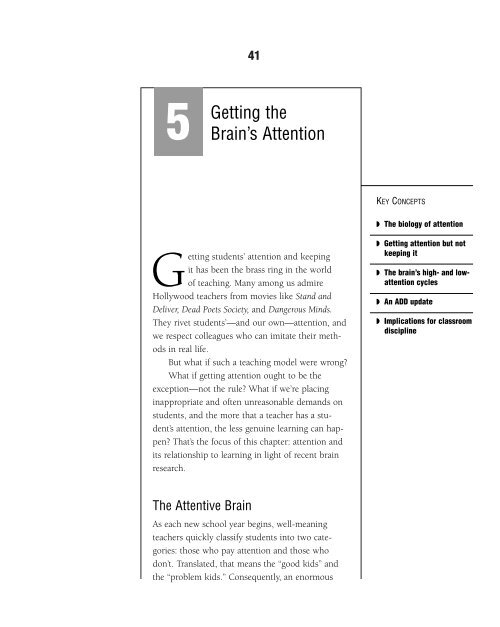You also want an ePaper? Increase the reach of your titles
YUMPU automatically turns print PDFs into web optimized ePapers that Google loves.
5 Gett<strong>in</strong>g<br />
41<br />
<strong>the</strong><br />
<strong>Bra<strong>in</strong></strong>’s Attention<br />
Gett<strong>in</strong>g students’ attention and keep<strong>in</strong>g<br />
it has been <strong>the</strong> brass r<strong>in</strong>g <strong>in</strong> <strong>the</strong> world<br />
of teach<strong>in</strong>g. Many among us admire<br />
Hollywood teachers from movies like Stand and<br />
Deliver, Dead Poets Society, and Dangerous M<strong>in</strong>ds.<br />
They rivet students’—and our own—attention, and<br />
we respect colleagues who can imitate <strong>the</strong>ir methods<br />
<strong>in</strong> real life.<br />
But what if such a teach<strong>in</strong>g model were wrong?<br />
What if gett<strong>in</strong>g attention ought to be <strong>the</strong><br />
exception—not <strong>the</strong> rule? What if we’re plac<strong>in</strong>g<br />
<strong>in</strong>appropriate and often unreasonable demands on<br />
students, and <strong>the</strong> more that a teacher has a student’s<br />
attention, <strong>the</strong> less genu<strong>in</strong>e learn<strong>in</strong>g can happen?<br />
That’s <strong>the</strong> focus of this chapter: attention and<br />
its relationship to learn<strong>in</strong>g <strong>in</strong> light of recent bra<strong>in</strong><br />
research.<br />
The Attentive <strong>Bra<strong>in</strong></strong><br />
As each new school year beg<strong>in</strong>s, well-mean<strong>in</strong>g<br />
teachers quickly classify students <strong>in</strong>to two categories:<br />
those who pay attention and those who<br />
don’t. Translated, that means <strong>the</strong> “good kids” and<br />
<strong>the</strong> “problem kids.” Consequently, an enormous<br />
KEY CONCEPTS<br />
◗ The biology of attention<br />
◗ Gett<strong>in</strong>g attention but not<br />
keep<strong>in</strong>g it<br />
◗ The bra<strong>in</strong>’s high- and lowattention<br />
cycles<br />
◗ An ADD update<br />
◗ Implications for classroom<br />
discipl<strong>in</strong>e



